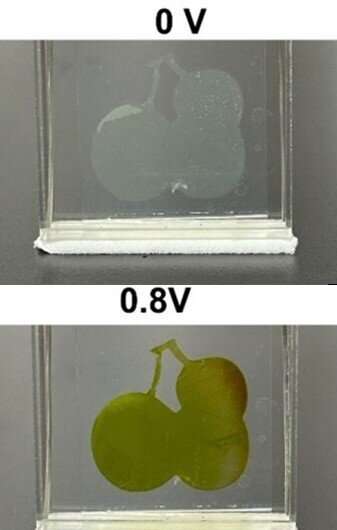
MAY 29, 2024 by American Chemical Society
Collected at : https://techxplore.com/news/2024-05-electrochromic-smart-windows-indoor-temperatures.html
Advances in electrochromic coatings may bring us closer to environmentally friendly ways to keep inside spaces cool. Like eyeglasses that darken to provide sun protection, the optical properties of these transparent films can be tuned with electricity to block out solar heat and light.
Now, researchers in ACS Energy Letters demonstrate a new electrochromic film design based on metal-organic frameworks (MOFs) that quickly and reliably switch from transparent to glare-diminishing green to thermal-insulating red.
Hongbo Xu and colleagues used MOFs in their electrochromic film because of the crystalline substances’ abilities to form thin films with pore sizes that can be customized by changing the length of the organic ligand that binds to the metal ion. These features enable improved current flow, more precise control over colors and durability.
In demonstrations, Xu’s MOF electrochromic film took two seconds to switch from colorless to green with an electric potential of 0.8 volts, and two seconds to switch to dark red with 1.6 V. The film maintained the green or red color for 40 hours when the potential dropped, unless a reverse voltage was applied to return the film to its transparent state.
The film also performed reliably through 4,500 cycles of switching from colored to clear. With further optimization, the researchers say their tunable coatings could be used in smart windows that regulate indoor temperatures, as well as in smaller scale intelligent optical devices and sensors.
In addition to Xu’s MOF-based electrochromic film, several other research groups have reported electrochromic coating designs, including a UV-blocking but visually transparent radiative cooling film, a colorful plant-based film that gets cooler when exposed to sunlight, and a temperature-responsive film that turns darker in cold weather and lighter when it’s hot.
More information: Biphenyl Dicarboxylic-Based Ni-IRMOF-74 Film for Fast-Switching and High-Stability Electrochromism, ACS Energy Letters (2024). DOI: 10.1021/acsenergylett.4c00492. pubs.acs.org/doi/abs/10.1021/acsenergylett.4c00492
Journal information: ACS Energy Letters

Leave a Reply